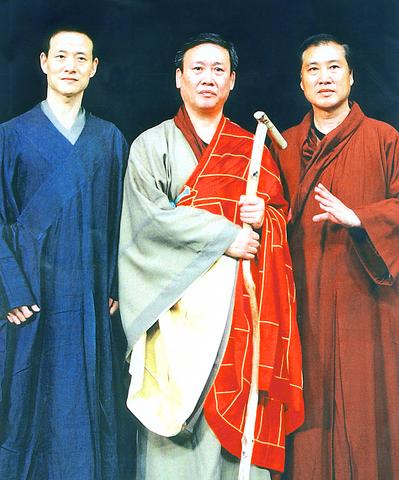Having perplexed readers and art lovers with both pen and brush, Noble Laureate Gao Xingjien (
Sponsored by the Council for Cultural Affairs (

PHOTOS COURTESY OF COUNCIL FOR CULTURAL AFFAIRS
In order to ensure the lavish production is, as critics are already dubbing it "a show for the 21st Century," Gao has called on the combined talents of theatrical and musical maestros from Taiwan, Hong Kong and France.
The show includes big name operatic star Wu Hsin-kuo (
"The sheer size of the production has led to many a sleepless night," admitted Council for Cultural Affairs spokesperson, Tchen Yu-Chiou (
It's not solely the on-stage action that sees Gao employing the talents of some of the nation's leading theatrical folk. The backstage crew includes Oscar winning costume designer, Tim Yip (
And like the performers, the backstage crew has also run into more than its fare share of quandaries in regards the nature of Gao's direction.
"I've been involved in over 100 shows over the years but this is certainly the most complex one I've ever dealt with," explained Nieh. "It's not simply a case of designing a set. There's also a need to understand the perplexing depth of Gao's writings. I come up with an idea one day, reread the script and realize I've missed the point and have to begin again."
To ensure the performance's western operatic elements are as genuine as possible, Gao is relying on the Opera de Marseille's conductor and musical arranger, Marc Trautmann, and the theatrical lighting skills of the French opera's stage illumination expert Philippe Grosperrin.
The problems arising from the complexities of Gao's stage direction will, according to the Nobel Laureate, be ironed out well in time for the show's premier in Taipei on December 19, when audiences will be treated to a truly breathtaking and breakthrough performance.
"The cooperation has been great," explained Gao. "Because of this I genuinely believe that such a collection of talented people will ensure that this one of most charged productions to ever be staged in Taipei."

May 11 to May 18 The original Taichung Railway Station was long thought to have been completely razed. Opening on May 15, 1905, the one-story wooden structure soon outgrew its purpose and was replaced in 1917 by a grandiose, Western-style station. During construction on the third-generation station in 2017, workers discovered the service pit for the original station’s locomotive depot. A year later, a small wooden building on site was determined by historians to be the first stationmaster’s office, built around 1908. With these findings, the Taichung Railway Station Cultural Park now boasts that it has

Wooden houses wedged between concrete, crumbling brick facades with roofs gaping to the sky, and tiled art deco buildings down narrow alleyways: Taichung Central District’s (中區) aging architecture reveals both the allure and reality of the old downtown. From Indigenous settlement to capital under Qing Dynasty rule through to Japanese colonization, Taichung’s Central District holds a long and layered history. The bygone beauty of its streets once earned it the nickname “Little Kyoto.” Since the late eighties, however, the shifting of economic and government centers westward signaled a gradual decline in the area’s evolving fortunes. With the regeneration of the once

In February of this year the Taipei Times reported on the visit of Lienchiang County Commissioner Wang Chung-ming (王忠銘) of the Chinese Nationalist Party (KMT) and a delegation to a lantern festival in Fuzhou’s Mawei District in Fujian Province. “Today, Mawei and Matsu jointly marked the lantern festival,” Wang was quoted as saying, adding that both sides “being of one people,” is a cause for joy. Wang was passing around a common claim of officials of the People’s Republic of China (PRC) and the PRC’s allies and supporters in Taiwan — KMT and the Taiwan People’s Party — and elsewhere: Taiwan and

Even by the standards of Ukraine’s International Legion, which comprises volunteers from over 55 countries, Han has an unusual backstory. Born in Taichung, he grew up in Costa Rica — then one of Taiwan’s diplomatic allies — where a relative worked for the embassy. After attending an American international high school in San Jose, Costa Rica’s capital, Han — who prefers to use only his given name for OPSEC (operations security) reasons — moved to the US in his teens. He attended Penn State University before returning to Taiwan to work in the semiconductor industry in Kaohsiung, where he